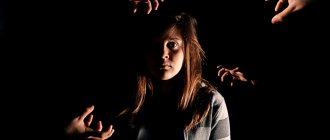June 07, 2021
Have you heard the phrase: “Man is the crown of nature’s creation”? But to reach this level, people had to constantly fight for their survival. In addition to climate disasters, many animals and insects posed a mortal danger to humans. Therefore, in modern psychology there is an opinion that zoophobia (fear of a certain group of animals) is of genetic origin. insectophobia occupies a special place .
Insectophobia (or entomophobia) is a collective name for obsessive panic fears of insects. People of any gender and age have been susceptible to this phobia since ancient times. But in adults, due to their greater psychological stability. it may not manifest itself as intensely as in children. Psychologists believe that the majority of the inhabitants of our planet have a mild form of insectophobia.
It can be expressed both in the form of fear of all insects, and in the form of fear of individual representatives.
Types of insectophobia
- scabiophobia – fear of ticks;
- apiophobia – fear of bees, wasps, bumblebees, hornets;
- millipodaphobia - fear of centipedes;
- arachnophobia – fear of spiders and arachnids;
- dipterophobia – fear of flies;
- isopterophobia – fear of termites and the like;
- cnidophobia – fear of various stinging insects;
- myrmecophobia – fear of ants;
- Scoleciphobia – fear of worms and larvae;
- parasitophobia – fear of parasites;
- phthyriophobia - fear of lice and others.
Since a person can encounter insects almost always and everywhere, people suffering from this phobia have a hard time. The fear of encountering an insect forces a person to be in constant tension. Such people avoid going outdoors and actively use repellents, mosquito nets, etc.
“I don’t like insects” or “I’m afraid”?
You can distinguish insectophobia from a simple reluctance to contact insects by these signs:
- The patient begins to panic at the sight of an insect. Experiencing severe fright, he tries to cover himself with his hands, hide or run away. The skin turns pale or, conversely, turns red due to an increase in blood flow to it, the pupils dilate, the patient experiences increased sweating, muscle hypertonicity (especially the back) and psychomotor agitation (motor restlessness of varying degrees of severity);
- the patient begins to be haunted by an obsession about a possible encounter with an insect. To protect himself, he begins to spray various poisons around himself, tries to keep all the windows closed, puts on protective clothing and is afraid to go outside;
- the patient is constantly in a state of anxiety. He begins to listen to the sounds around and expects an insect to appear any minute;
- the patient becomes unable to hear reasonable arguments about the groundlessness of his fear.
These symptoms are characteristic of all types of phobias and are a sign that a person needs treatment - there is a high risk of developing severe mental manifestations, in which the patient is quite capable of starting to harm himself. There are known cases when people with insectophobia rubbed their bodies with poisonous ointments so that hated insects would not approach them, tried to fight them with open fire, etc.
Insectophobia is expressed more or less clearly depending on the individual characteristics of a person’s mental development. For example, in children any phobias are more pronounced than in adults.
Somatic manifestations:
- dilated pupils,
- muscle hypertonicity, trembling of arms and legs,
- increased heart rate,
- paleness/redness of the skin,
- psychomotor agitation,
- changes in blood pressure,
- profuse sweating,
- nausea,
- difficulty breathing, shortness of breath,
- weakness, faintness;
- panic attacks.
An insectophobe has a desire to run away from the insect or deal with it. He loses the ability to think rationally and in this state can harm himself and others.
First aid for panic attacks
In a moment of panic, a person thinks that he will suffocate, die, or go crazy. Somatic symptoms include ringing in the ears, dizziness, and nausea. It is better to entrust the treatment of panic attacks to a specialist; in this case, drug treatment is indicated. But it's important to know what you can do if a panic attack takes you by surprise.
First aid for a panic attack:
- focus on any object, this is necessary to switch attention;
- take several deep, long breaths in and out, this is necessary to normalize breathing and heartbeat.
You can use a paper bag. Take one deep breath and after eight seconds exhale slowly into the bag, repeat the procedure for five minutes.
Exercise and communication with loved ones are indicated as additional methods and means of prevention. Try to spend less time alone, especially before an upcoming meeting with the subject of fear.
The objective ones include the following:
- Negative consequences after contact with insects (bites of bees, wasps, mosquitoes, etc.). A sharp feeling of pain and the allergic reaction that develops after this becomes a psychotraumatic situation that leads to the formation of a phobia.
- Parental behavior . A small child repeats after his parents their hysterical reaction to an insect, or he was frightened by scary stories about dangerous insects (remember “The Cockroach” by K. Chukovsky!).
- Medical problems . The presence of brain injuries, schizophrenia, syphilis, meningitis, cirrhosis, mental retardation, as well as alcoholism and drug addiction can give rise to this phobia in a person.
Treatment
Treatment of insectophobia takes place in two stages:
- Search for the cause: a traumatic situation in the subconscious, memory.
- Working on the situation, rethinking.
First, the psychotherapist finds the reason that provoked the phobia. The patient sees the situation differently. Once the cause is eliminated, the symptoms also go away. Over time, the person completely gets rid of the phobia.
Supportive therapy is also provided. This is the attachment of positive associations to insects of the species that frighten the patient. Psychologists show fear from the other side and explain the degree of real danger. The patient understands how exaggerated his fears were. There is no more panic. If necessary, the doctor will prescribe medication to eliminate anxiety and destructive manifestations of fear for the body.
Far-fetched reasons
- Fear from the thought that an insect could get into the mouth, nose, stomach, even the brain.
- The influence of the media (stories, films, computer games, etc.), which describe huge, terrible insects that are aggressive towards people.
- Fear of infection (being bitten). Most insectophobes are afraid of getting infected from insects. No one denies the fact that insects can carry infections, but in relation to these people, fear goes beyond all limits of reason.
- Increased impressionability and wild imagination . Sometimes people are disgusted by the mere appearance of an insect. And if we add to this a person’s lack of reliable knowledge about these creatures, then as a result an inexplicable fear may develop, turning into a phobia.
Self-medication
Not everyone has the opportunity to visit a psychotherapist. Self-medication is better than inaction. If you have psychological and physical signs of a phobia, try these self-treatment methods. It’s worth mentioning right away that you can’t prescribe any sedatives yourself. For advice on taking medications, consult a therapist or neurologist. The doctor will recommend medications that are suitable for a particular case.
Recommendations for adults
First of all, do some self-analysis. Write down everything that scares you. What to do next?
- Analyze each episode as if you were a psychologist. Explain that the fear was not real, it was fantasy, panic.
- Ask your parents if you were bitten by insects as a child. Often the causes of phobias are rooted in childhood.
- Read about the insects you are afraid of. See pictures. Not terrible ones, but ones where they behave peacefully in nature.
- Do your research: You must understand the real danger.
- Consider whether others feel the same way when they are near the object of fear.
- Learn to tolerate the presence of this insect nearby. Then try to touch it if it is not life-threatening. For example, if you are afraid of spiders, then you should come to a special pet store that sells them. The seller will tell you everything and let you hold the spider, which is not dangerous at the moment.
Many people, after getting rid of a phobia, keep insects at home
Recommendations for children
Children's fears are more difficult to overcome. It's better to talk to a psychologist. This can be done via a helpline, online or in person by making an appointment.
You can only read fairy tales with your child in which insects appear as heroes. There are wonderful cartoons about bees and ants.
You also need to talk with adult children about fears and try to find out the reason. Show that the fear is exaggerated. The usual precautions are sufficient.
About the benefits of stress
Stress is a beneficial physiological response that dictates our behavior in potentially dangerous situations that require close attention. This is a natural process that is a response to suspicious external factors (barking dogs) or excitement (riding on dizzying rides). When these and other situations occur, the nervous system sends signals to release adrenaline. This hormone prepares your body for a response known in psychology as “fight or flight.”
Desensitization, or exposure therapy, to treat insectophobia
Desensitization or exposure therapy to treat insectophobia helps overcome fear by exposing the patient to the object of fear. For example, the first images of insects are shown so that the patient can influence and reduce his level of anxiety. Slowly, as the patient begins to understand that not all insects are harmful, he is taken out into the garden where he may come into contact with flies or bedbugs.
Phobia as a type of anxiety disorder
Serious head trauma can be a prerequisite for the development of certain types of phobias. Also at risk are people suffering from depression or substance abuse. The presence of any type of phobia potentially indicates preconditions for the development of an anxiety disorder. The symptoms of irrational fear themselves are very similar to this form of mental disorder. You see that there is no real danger, but nevertheless you panic and greatly exaggerate the threat.
Documents created during the Second World War can be classified as book monuments
Like a rug: Jane decorated an old concrete porch with a stencil and paint
Video of a disappearing lake in Oregon captivates from the first minutes of viewing
Scary appearance
The second reason why people are afraid of insects lies in the terrifying appearance of these small creatures. The anatomy of arthropods is completely alien compared to human anatomy. Flies, beetles, spiders and wasps have multiple appendages on their bodies, as well as disproportionately large eyes, consisting of several thousand small eyes connected together. If you look at an enlarged image of a fly or spider, it is unlikely that the sight will cause you any emotion. Quite the contrary.
Signs and symptoms
Symptoms that may indicate entomophobia or insectophobia:
- Constant complaints of insect bites are the main symptom of insectophobia, that is, a phobia such as fear of insects.
- Reclusion.
- Reading about insects to see if fear is rational.
- Obesity.
- Frequent visits to doctors due to skin problems.
- When thinking about insects, physical tension appears, expressed in symptoms such as shortness of breath, nausea, and vomiting.
- A panic attack at the sight of an insect is also a sign of insectophobia.
- Isolation from society.
The symptoms are so common that a person often does not realize that they are developing a phobia - the fear of insects. The main symptoms of any phobia are:
- Panic when confronted with the cause of fear or even at the thought of the source of fear.
- The desire not to leave the house in order to avoid confrontation with the source of fear.
- A feeling of powerlessness due to the fact that a person cannot control fear, even knowing that it is irrational.
- The children start crying.
- Development of physical symptoms such as inability to breathe, sweating, and vomiting.
How to get rid of myrmecophobia - fear of ants: treatment
IMPORTANT: Myrmecophobia is a word of Greek origin: myrmex - ant, phobos - fear.
The fear of ants is justified by the fact that some of their species are dangerous to humans (the bite of a fire ant can cause suffocation and death, and red ants bite very painfully) and his property (black ants can destroy wooden buildings). Fear is fueled by numerous stories and films about deadly ants. Ant bites on the street can lead to the development of a phobia in children. A person with myrmecophobia is afraid of the sight of ants; it seems to him that small insects live in his house, crawling on his things and products.
The fire ant, its bite can be fatal to humans.
Having diagnosed a patient with a fear of ants, the psychiatrist will advise him to desensitize his fear in the same way as for arachnophobia.
Risk factors
There are several factors that may put you at risk of developing a phobia:
- If you notice that anyone close to you, such as father, mother, brother, etc., suffers from insectophobia, you risk developing this fear in yourself as well.
- If you have experienced a traumatic incident in the past, you may develop fear of the source.
- Specific phobias develop even at the age of 10, so you become unable to interact with people.
Ways to get rid of fear
Insectophobia can be successfully treated . You can try to cope with it on your own. There are some tricks for this. But it is better to seek help from professional psychotherapists who guarantee that this fear will be overcome after undergoing therapy.
In order to attempt to get rid of this problem on your own, you need to try the following steps:
- You need to find out some interesting information about the world of insects. To do this, you need to purchase colorful books that tell about this world. There are encyclopedias that describe the life of insects in detail. This approach is suitable for both children and adults. When a person learns in more detail about how the creatures that cause him fear live, the fear may recede.
- Decorate your living space with images of insects. Some manufacturers specially produce wallpaper collections with this print. They depict representatives of the insect world in all their diversity. Such collections are mainly bought by people who have such a phobia. You don't have to limit yourself to just wallpaper. There are many ways to decorate your space with insect keepsakes. They can be quite cute if they are beautifully decorated and placed in the right place. Over time, constantly being surrounded by insects, a person stops reacting violently to them. Many people successfully cope with this fear using this method.
- If fear is caused after watching a feature film where arthropods are not shown in the best light, then it is worth watching a video telling about their way of life. It would be better if you could find films that show how safe they are and in what cases you should be wary of them. After all, most insects are harmless. Many peoples even eat them.
Where does the fear of insects come from?
This question has not yet been given a clear answer. However, there are two main theories to explain this phenomenon:
Freud's psychodynamic theory
This theory greatly influenced science, but has already lost its popularity. Freud explained this by a connection with a mechanism that pushes stimuli into the subconscious that protect a person when danger arises. Man sought to keep nature under control and drowned out these signals of hidden alarm. This caused distortions in his mental defense mechanism. Anxiety moved to the unconscious level, giving rise to fear of ordinary objects subject to human control. They could be arthropods. Fear is in the subconscious. This is why man cannot govern. According to Freud, only a specialist can help with this.
Behavioral theory
This theory is supported by most scientists. Her followers say that insect phobia is formed at a time when a person feels fear, in two ways: conditioned and modeled.
Conditional path
According to experts, the cause of fear of insects is usually mental trauma from childhood. An impressionable child who is just beginning to explore the world can see a terrible monster in any small bug. A mosquito bite or buzzing noise can cause severe discomfort. The insect may appear unexpectedly and frighten him or be in a place where a frightening situation has occurred. And despite the fact that it has nothing to do with this event, the child develops bad associations.
If this fear sits deep inside a person’s consciousness, then it is very difficult to overcome it. You should seek the help of a psychologist.
Sometimes fear of insects also appears in an adult if he becomes a victim of an attack, for example, by bees.
Simulated path
This variant of the formation of fear of insects is associated with its acquisition from the outside. The child copies the behavior of his parents and other close people by observing them. If one of the family members has a similar disorder and somehow shows it, then the baby will begin to think that he should be afraid too.
Insectophobia can also be caused by parents prohibiting them from picking up insects. The child will begin to perceive them as something bad and scary. Therefore, you should not make this mistake.
Another source of fear of insects is scary stories and films where they are presented as villains, attacking people or simply looking scary.
To avoid such situations, parents are advised to monitor their behavior and the media products that are offered to their children. And if fear has nevertheless formed, you should not delay going to a specialist.
Independent actions
If the case is not advanced and your phobia is at the initial stage of development, it is important to understand what exactly is bothering you - what insects and possible causes of fear. By answering these questions yourself, you can choose how to deal with your fear of insects.
- If you are afraid of the unknown or there is no information about this or that representative of the macrocosm, you should read an encyclopedia about insects, study pictures, detailed descriptions. You can also watch documentaries, just make sure (ask someone to watch the film in advance) that it does not contain scenes that frighten you, for example, contact of insects with people, insect attacks on humans, etc. This method is suitable for both children, as well as for adults.
- If the cause of your fear is a feature film, you should watch it again, not forgetting that everything that happens on the screen is fiction. When using this method with children to help them get rid of their fear of insects, think carefully about the approach, otherwise the situation may only get worse.
- If insects are simply unpleasant to you, for no apparent reason, consider buying photo wallpaper depicting representatives of the macrocosm. Souvenirs and accessories will also help - having gotten used to seeing only decorations in an insect, a person will gradually forget about fear.
How to overcome fear?
Insectophobia, like other mental disorders, is treated with cognitive behavioral therapy, as well as suggestive therapy (appealing to logic, reason and facts). The dual approach forces the patient to focus on working to overcome the disgust factor, fear and anxiety associated with insects, as well as control their behavioral reactions. Relaxation procedures help to cope with the emotional response. Therapists also help people identify and retrain the thinking patterns that contribute to feelings of fear.
Found a violation? Report content
Insectophobia – panic fear of insects
Insectophobia is a mental disorder characterized by an intense fear of insects. Another name for it is entomophobia. As a rule, a person suffering from this disorder is frightened not by all creatures in a row, but by certain types of them, for example, bees, wasps, cockroaches, flies, ants, fleas, spiders, bedbugs. Some patients have a fear of all insects.
Manifestations of a phobia can range from hostility and disgust to panic horror at just the sight of a flying or crawling insect.
Methods for correcting the condition
Additional therapy may include antidepressants, antipsychotics, and sedatives. They eliminate somatic symptoms, as well as possible complications during panic attacks.
In extremely severe cases, hypnotherapy may be required. Sometimes specialists from other medical fields come to the aid of a psychotherapist when the trigger for fear is physiological trauma. In this case, it becomes clear which specialist deals with this disease. It is possible to develop allergic reactions from bites of ants, bees and other insects. This can be complemented by psychological problems, so an integrated approach is required to heal from the pathology.
Complications
A phobia that bothers someone and causes serious problems in their life may not seem like a concern to others. A patient suffering from insectophobia may have many complications, such as:
- Avoiding any social interaction because of the thought that people might laugh at him. This behavior can lead to reclusiveness and loneliness.
- The complication of insectophobia leads to clinical depression or develops anxiety disorders.
- Substance abuse to cope with stress caused by fear.
How to get rid of scoleciphobia - fear of worms: treatment
Worms are vile and disgusting. They, like huge inhabitants of dungeons, became heroes of ancient myths. Not everyone dares to pick up a worm. But those who are terrified of them are said to suffer from scoleciphobia.
Art therapy is used to treat scoleciphobia.
In addition to desensitizing fear, a psychiatrist, as part of the treatment of fear of worms, can recommend art therapy to the patient - draw a worm as the monster the patient imagines it to be, and then destroy the drawing.
How is fear of insects treated using psychotherapy?
A cure for insectophobia is quite possible. Despite the specificity of this disorder, it has a completely understandable clinical picture. Therapy is considered the most effective method. The client encounters an object that provokes his phobia.
The following methods are distinguished:
- human simulation;
- flood;
- systematic desensitization.
During the simulation of the situation, the psychologist actively interacts with the subject of fear in order to demonstrate the exaggeration of this phobia and the harmlessness of arthropods. The client needs to mentally join the specialist and his victory in order to recognize the artificiality of insectophobia.
In a flood, the client is exposed to a fear trigger a number of times—therapists describe the source in an exaggerated manner. The person experiences a surge of emotions, and at the end of the procedure, the specialist illustrates the frivolity of the fear of insects due to the absence of real harm to the planet by its arthropod inhabitants. In this way, he influences the client’s subconscious, convincing him of the groundlessness of the phobia.
Systematic desensitization is the use of relaxation training to help the client relax. With the help of this, the specialist builds a hierarchy of his fears.









